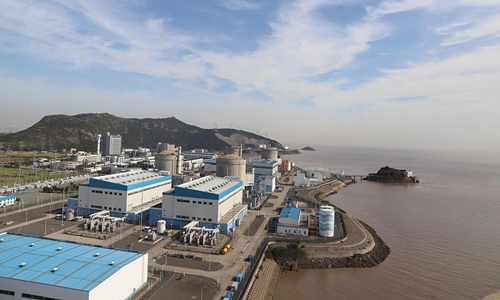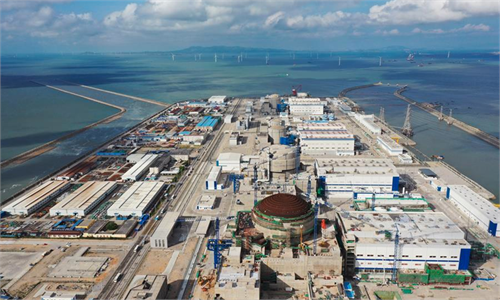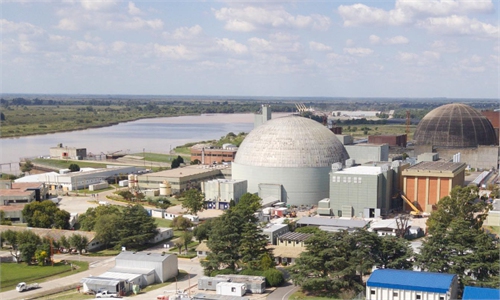
Qinshan Nuclear Power Station in East China's Zhejiang Province Photo: CFP
A report released by China Nuclear Energy Industry Association on Wednesday called for nuclear technology application to be elevated into China's national strategy and integrated into the overall national economic and social development blueprint.
Conservative estimates showed the output value of China's nuclear technology application industry has exceeded 700 billion yuan ($99 billion) as of the end of 2022, with the average annual growth rate remaining above 15 percent, Zhang Tingke, the Vice Chairman and Secretary-General of China Nuclear Energy Industry Association addressed 2023 International Conference on Nuclear Technology Application that kicked off Wednesday in Haiyan, East China's Zhejiang Province.
China's nuclear technology application industry will play a bigger and prominent role in promoting new industrialization, building a strong manufacturing country, a strong country, a strong space transportation network, a digital China, and a healthy, safe and beautiful China. The domestic nuclear technology application has vast future potential, and it is expected to reach a trillion yuan in market size by 2025, Zhang said.
China Nuclear Technology Application Industry Development Report (2023) that was released at the conference on Wednesday called for nuclear technology application to be elevated into a national strategy and integrated into the overall national economic and social development blueprint.
The report said that ordinary people's "clothing, food, shelter, transportation" have been widely benefited from the use of nuclear technology, the "hero behind the scenes," "and it has become "inseparable" with human beings.
As a modern high-tech industry, nuclear technology is mainly used in fields like nuclear agriculture, industrial nuclear technology, medical nuclear technology, space and geonuclear technology, environmental protection and social security, according to the report.
During COVID-19 epidemic, nuclear technology also played an important role in the fight against the epidemic through irradiation sterilization, saving lives and blessing mankind, Zhang said. According to the report, "millions of medical protective suits, masks, helmets and goggles were sterilized by radiation and used in the clinical fight against COVID-19, buying precious time for saving lives."
In the future, combined with cloud computing, big data, deep learning, immunology, molecular biology and other disciplines, nuclear technology is expected to become a strategic source of new technologies, the report noted.
Nuclear applications can also be deeply involved in integrated circuits, biomedicine, advanced structural materials, new functional materials and rail transportation equipment to help strengthen the country's emerging industries, according to the report.
Stronger nuclear technology will also contribute to China building a healthy, safe and beautiful country. Radiation analysis technology has been used as an effective method to inspect and detect all kinds of hidden contraband, for example, the report continued.
When the domestic nuclear technology application has entered a period of rapid breakthrough, China's nuclear technology has also taken steps to "go out."
In response to the IAEA's "Ray of Hope" initiative, some central enterprises have taken the initiative to help low- and middle-income developing countries improve cancer diagnosis and treatment capacity.
Complete sets of equipment related to customs security check, electronic accelerator for industrial irradiation, cobalt-60 irradiation integrated device and other products have been exported to overseas markets along the Belt and Road, according to the report.
But various challenges lie ahead for China in developing nuclear technology, Zhang noted in his remarks. The country's independent and controllable R&D ability in this regard is relatively insufficient, and some key core technologies are heavily dependent on foreign imports.
Compared with developed countries in Europe and the US, the output value of the nuclear technology application industry in China's GDP is still at a low level, Zhang said.
According to the report, more than 150 countries and regions in the world have carried out research, development and application of nuclear technology. The nuclear technology application industry in developed countries has already achieved a mature business model. The output value of closely related industries in those countries now accounts for more than 2 percent of their GDP.
The value of nuclear technology applications in the US has reached $600 billion, accounting for about 3 percent of its GDP and the percentage in Japan, South Korea, Sweden and the big EU countries ranges from 2 percent to 3 percent.



